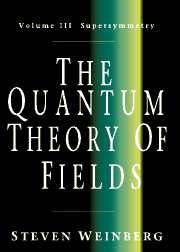Book contents
- Frontmatter
- Contents
- PREFACE TO VOLUME III
- NOTATION
- 24 HISTORICAL INTRODUCTION
- 25 SUPERSYMMETRY ALGEBRAS
- 26 SUPERSYMMETRIC FIELD THEORIES
- 27 SUPERSYMMETRIC GAUGE THEORIES
- 28 SUPERSYMMETRIC VERSIONS OF THE STANDARD MODEL
- 29 BEYOND PERTURBATION THEORY
- 30 SUPERGRAPHS
- 31 SUPERGRAVITY
- 32 SUPERSYMMETRY ALGEBRAS IN HIGHER DIMENSIONS
- AUTHOR INDEX
- SUBJECT INDEX
26 - SUPERSYMMETRIC FIELD THEORIES
Published online by Cambridge University Press: 05 May 2013
- Frontmatter
- Contents
- PREFACE TO VOLUME III
- NOTATION
- 24 HISTORICAL INTRODUCTION
- 25 SUPERSYMMETRY ALGEBRAS
- 26 SUPERSYMMETRIC FIELD THEORIES
- 27 SUPERSYMMETRIC GAUGE THEORIES
- 28 SUPERSYMMETRIC VERSIONS OF THE STANDARD MODEL
- 29 BEYOND PERTURBATION THEORY
- 30 SUPERGRAPHS
- 31 SUPERGRAVITY
- 32 SUPERSYMMETRY ALGEBRAS IN HIGHER DIMENSIONS
- AUTHOR INDEX
- SUBJECT INDEX
Summary
Now we know the structure of the most general supersymmetry algebras, and we have seen how to work out the implications of this symmetry for the particle spectrum. In order to learn what supersymmetry has to say about particle interactions, we need to see how to construct supersymmetric field theories.
Originally the construction of field supermultiplets was done directly, by a repeated use of the Jacobi identities, much as in the construction of supermultiplets of one-particle states in Sections 25.4 and 25.5. Section 26.1 presents one example of this technique, used here to construct supermultiplets containing only scalar and Dirac fields. Fortunately there is an easier technique, invented by Salam and Strathdee, in which supermultiplets of fields are gathered into ‘superfields,’ which depend on fermionic coordinates as well as on the usual four coordinates of spacetime. Superfields are introduced in Section 26.2, and used to construct supersymmetric field theories and to study some of their consequences in Sections 26.3-26.8. This chapter will be concerned only with N = 1 supersymmetry, where the superfield formalism has been chiefly useful. At the end of the next chapter we will construct theories with N-extended supersymmetry by imposing the U(N) /∧-symmetry on theories of N = 1 superfields.
Direct Construction of Field Supermultiplets
To illustrate the direct construction of a field supermultiplet, we will consider fields that can destroy the particles belonging to the simplest supermultiplet of arbitrary mass discussed in Section 25.5: two spinless particles and one particle of spin 1/2.
- Type
- Chapter
- Information
- The Quantum Theory of Fields , pp. 55 - 112Publisher: Cambridge University PressPrint publication year: 2000



